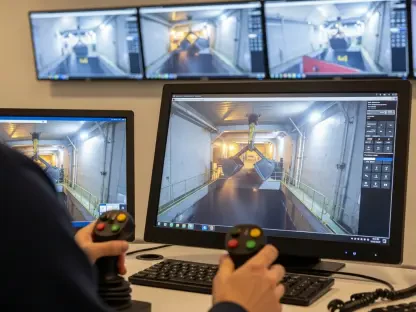In a groundbreaking advancement for telecommunications technology, the Industrial Technology Research Institute (ITRI) and its esteemed partners have launched trials showcasing the potential of non-terrestrial networks (NTN) integrated with 5G technology. This collective effort, involving industry giants such as Eutelsat, MediaTek, Airbus, and Chunghwa Telecom (CHT), aims to revolutionize global connectivity by merging terrestrial and satellite networks through state-of-the-art 5G interfaces. Such innovations promise to bridge the gap in areas with limited cellular coverage, bringing the benefits of high-speed internet to underserved regions across the globe.
Breakthrough in 5G NTN with LEO Satellites
LEO Satellite Collaboration and Technological Feats
ITRI, in conjunction with Eutelsat, MediaTek, and Airbus, pioneered a trial using low Earth orbit (LEO) satellites, setting the stage for a new era in satellite communication. The highlight of this trial was a revolutionary 5G terminal device, powered by MediaTek’s NR-NTN test chip, establishing an exceptional connection with ITRI’s NTN gNB. This connection was facilitated through a Ku-band Eutelsat OneWeb satellite link, enabling seamless traffic exchange with a satellite constructed by Airbus. This remarkable feat not only confirms the feasibility of integrating LEO satellites with 5G technology but also demonstrates its potential to significantly enhance data transmission and connectivity.
The successful trial of this terminal device illustrated the exceptional capabilities of LEO satellites in ensuring high-speed data transfer and low-latency communication, akin to terrestrial 5G networks. This achievement is particularly crucial considering that LEO satellites orbit closer to Earth, providing stronger and more reliable signals. The MediaTek chip’s performance in the trial underscores the potential for wide-scale deployment of such devices, paving the way for advancements in fields like remote sensing, emergency response, and broadband access in remote locations.
Implications for Connectivity and Market Expansion
The implications of these successful trials extend beyond technological achievements, hinting at an expansive market transformation driven by the integration of 5G and NTN solutions. By demonstrating a working model of satellite-to-terrestrial communication, these trials validate the commercial viability of deploying LEO satellites to offer broadband services worldwide. This seamless integration can lead to enhanced connectivity across various sectors, including the Internet of Things (IoT), automotive industries, and even telemedicine, where rapid data exchange can drastically improve service delivery and operational efficiency.
Furthermore, the collaboration among industry leaders in this endeavor signifies a unified understanding of the commercial and practical benefits of implementing NTN solutions. As these technologies mature, we can anticipate the creation of new business models and services that cater to both urban and rural populations. The potential for ubiquitous connectivity enhances prospects for smart city projects, disaster management systems, and the bridging of digital divides in regions previously deemed unreachable. The ultimate goal is a future where fast, reliable internet access is not a luxury but a standard service available to all.
Advancing 5G NTN with GEO Satellites
GEO Satellite Trials and Their Achievements
In addition to breakthroughs with LEO satellites, ITRI and Chunghwa Telecom (CHT) have been at the forefront of demonstrating the capabilities of geostationary (GEO) satellites in advancing 5G NTN technology. The trials featured the use of CHT’s commercial ST-2 satellite, showcasing a wideband 5G NTN connection that stands out in its class. Utilizing a Ku-band ST-2 satellite link, the trials involved a two-way video call based on 3GPP NTN specifications, achieving high spectrum efficiency of up to 2bps/Hz. This remarkable achievement signifies a high level of innovation, aligning with the global standards required for next-generation communications.
The successful demonstration marked a critical advancement in the field of satellite communications, proving that GEO satellites are indeed capable of supporting 5G NTN. These satellites, positioned at high altitudes and remaining fixed relative to the Earth’s surface, are optimal for providing consistent coverage over extensive areas. The ability to conduct a real-time video call with minimal latency over such a satellite network demonstrates the robustness and potential of GEO satellites to complement terrestrial networks, thereby expanding the reach of 5G services to broader regions.
Industry Perspectives and Future Prospects
The industry has shown strong support for these pioneering efforts, recognizing the significant benefits of integrating multi-orbit satellite resources. Pang-An Ting from ITRI emphasized the innovative design and high flexibility of ITRI’s NTN base station, which was evident in the successful demonstration of 5G multi-orbit NTN satellite connectivity. Ting highlighted the goal of creating a seamless convergence of NTN and terrestrial networks, setting the stage for new opportunities in global use cases for 5G devices. This collaborative spirit among industry leaders fosters a technology-driven environment focused on enhancing user experiences and connectivity solutions.
Chunghwa Telecom’s Chung-Yung Chia echoed this sentiment, highlighting the company’s commitment to evolving satellite technologies and supporting the Taiwanese satellite industry’s growth. Chia underscored the collaborative efforts needed to integrate multi-orbit satellite technologies, aiming to boost the reach and reliability of communication services. Mingxi Fan of MediaTek also reinforced the importance of these innovations, emphasizing their mission to connect even the most remote regions efficiently. The consensus within the industry reflects a shared vision for leveraging 5G and NTN technologies to create a more connected, digital world.
Moving Forward with 5G NTN Innovations
The Industrial Technology Research Institute (ITRI) and its reputable partners have made a significant leap in telecommunications technology by initiating trials that display the capabilities of non-terrestrial networks (NTN) integrated with 5G. This collaborative venture, with notable contributions from industry leaders like Eutelsat, MediaTek, Airbus, and Chunghwa Telecom (CHT), aspires to transform global connectivity. By combining terrestrial and satellite networks using advanced 5G interfaces, these innovations aim to close the digital divide in regions with sparse cellular coverage. This breakthrough in merging 5G and satellite networks holds the potential to bring high-speed internet access to remote and underserved areas worldwide, significantly enhancing the quality of life and economic opportunities. The success of these trials could lead to a more connected planet, ensuring that even the most isolated communities can benefit from modern communication technologies.









